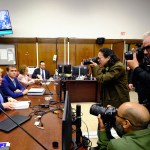On the one hand, there are benchmarks for Iraq, which can be subject to political manipulation. On the other hand, there’s how life in Baghdad is actually lived by Iraqis. And a new report by IraqSlogger gives a glimpse at how tenuous that life can be.
IraqSlogger, the most comprehensive web resource on Iraq, put together a 95-page overview of a topic as ignored in the U.S. as it is crucial to Iraqis: the conditions of Baghdad’s bridges. As the sprawling city is bisected by the Tigris river and the Army Canal, and belted at its south by the Diyala River, it’s these access routes that determine how habitable the city is. Control of the area around a certain bridge by an insurgent group or militia is an invaluable resource.
The report costs $495. But we’ve been able to get a peek at what it contains. And sure enough, the bridges and their surrounding neighborhoods are battlegrounds for Iraq’s multifaceted sectarian war. The spillover effect of unsafe areas nearby the bridges deeply influences Baghdad — something that demonstrates just how much of a long shot Gen. David Petraeus’ “population protection” strategy is.
Almost all of the Tigris bridges remain open outside of curfew. (The Ai’mma Bridge is the exception.) That’s a matter of economic necessity: to close the bridges would cripple the city. As a result, the Iraqi Army maintains checkpoints on all bridges, with the U.S. military controlling only the 14th of July Bridge. Most contain restricted access, with lanes of traffic choked off in order to hinder the ability of a car or truck bomb to inflict damage during periods of heavy congestion.

Some have become associated with insurgent or militia attacks. The Sunni belts north and south of the city are a case in point. The northern Muthanna Bridge has a reputation for “lawlessness,” with either side of it considered “very dangerous”; while the southern Hasanayn, despite its “great capacity,” is “sparsely traveled,” as it leads to “a dangerous area to most Iraqis, under the control of militant Sunni groups.” Similarly, the Jadiriya Bridge, according to the report, is in the hands of the Badr Corps, the Shiite militia loyal to the Supreme Islamic Iraqi Council.
Others pit drivers right into the sectarian conflict. Consider the 14th of Ramadan Bridge, one of 14 spans over the Tigris. The bridge is open outside of the city’s 10 p.m. to 5 a.m. curfew, and it flows eastward into the all-Sunni Adhimiya neighborhood, the last bastion of Sunni East Baghdad after Shiite militias essentially cleansed the area in 2005 and 2006. (Adhimiya was made famous this spring by a much-protested U.S. project to build a wall around the enclave separating sectarian combatants.) The trouble is that the territory surrounding the bridge’s west bank is run by the Mahdi Army; and the entrance to Adhimiya is patrolled by members of Tawhid and Jihad, Abu Musab al-Zarqawi’s old outfit.
According to the report, Shiites are in particular danger from the route marked by the 14 of Ramadan bridge. In April, insurgents destroyed the much-safer Sarafiya bridge, which routed much Baghdad traffic to the nearby Bab al-Mu’adham Bridge. That means traveling along Haifa Street, an arterial road and “dangerous area for Shiites especially.” Very likely, that was the intent of the bridge demolition: to herd Shiite traffic into a predictable and vulnerable pattern.
That’s not all the damage that bridge attacks can inflict. If the al-Sinak bridge were to meet the same fate as the Sarafiya, Baghdad’s commercial center would be “paralyzed,” the report states. Along the Diyala River is the Nahrawan Bridge, a major transport route for masonry — crucial in a city segmented by endless blast walls. Iraqi employees of the U.S.-controlled Green Zone travel along the 14th of July and Jumhouriya bridges — the 14th of July is in fact reserved entirely for Green Zone workers — meaning sustained attack on those would severely restrain activity inside the four-square-mile complex. And since all bridges over the Tigris contain Iraqi Army checkpoints, the occasional attacks on them raise the question of Army infiltration by insurgents.
When Petraeus testifies next month about progress made by the surge, he probably won’t spend much time discussing conditions on and surrounding Baghdad’s bridges. But for a glimpse of how precarious life can be in Baghdad, IraqSlogger’s report is fascinating.





 (The Unsafe) Bridges of Babylon
(The Unsafe) Bridges of Babylon


